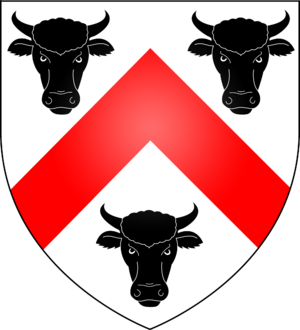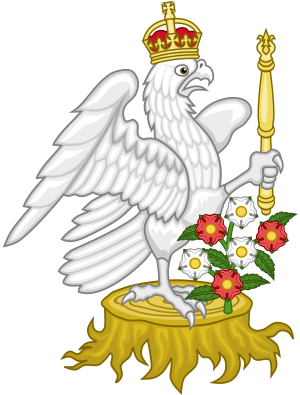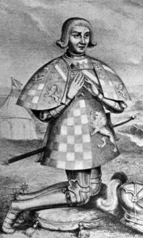George Boleyn, Viscount Rochford facts for kids
Quick facts for kids
George Boleyn
|
|
|---|---|
| Viscount Rochford | |

The Boleyn family coat of arms. George's father later used the arms of the Butler family.
|
|
| Born | c. 1504 Blickling Hall, Norfolk |
| Died | 17 May 1536 (aged 31–32) Tower Hill, London |
| Buried | Chapel Royal of St. Peter ad Vincula, Tower of London 51°30′31″N 0°04′37″W / 51.508611°N 0.076944°W |
| Noble family | Boleyn |
| Spouse(s) | |
| Father | Thomas Boleyn, 1st Earl of Wiltshire |
| Mother | Elizabeth Howard |
| Occupation | Diplomat, politician, poet |
George Boleyn, Viscount Rochford (born around 1504 – died 17 May 1536) was an English courtier (someone who attends a royal court) and nobleman (a person of high rank). He was very important in the politics of the early 1530s because he was the brother of Anne Boleyn, who became the second wife of King Henry VIII. George was also the uncle of Queen Elizabeth I, though he died many years before she became queen. In 1529, when his father became the Earl of Wiltshire and Earl of Ormond, George started using his father's second title, Viscount Rochford, as a special "courtesy title." He was executed after his sister Anne was put on trial for serious crimes against the King.
Contents
Early life and family
George was the son of Thomas Boleyn and Elizabeth Howard. His mother's father was Thomas Howard, a powerful duke. This made George a nephew of the future 3rd Duke of Norfolk and a cousin of the famous poet Henry Howard.
George and his sisters were likely born in Norfolk at their family home, Blickling Hall. However, they spent most of their childhood at Hever Castle in Kent. This castle became their main home in 1505 when George's father inherited it.
George had two older sisters, Mary and Anne. He also had two brothers named Thomas and Henry who died when they were young. Most historians agree that George was born around 1504, making him the youngest of the three surviving Boleyn children.
Just like his father, George was expected to have a career at court, working as a politician and a diplomat (someone who represents their country abroad). Serving the King was the best way for a family to gain wealth and social standing. So, George was introduced to King Henry VIII's court when he was only ten years old, attending Christmas parties in 1514–1515. He even performed in a play with his father and other important courtiers. Because of his family's influence and his ability to impress the King, he soon became one of the King's pageboys (a young male attendant).
George received an excellent education, which was very important for a diplomat. He spoke fluent French and knew some Italian and Latin. While his sisters were educated abroad, George likely stayed in England. However, some believe he might have spent time in France as a child, which would explain his perfect French. George is also thought to have attended the University of Oxford, though his name doesn't appear in the official records. This was common for noble students at the time.
Personal life
We don't know as much about George's personal life as we do about his career at court. We do know that he married Jane Parker around 1524. A note from 1526 by Cardinal Thomas Wolsey confirms they were married, as it mentions extra money given to "young Boleyn for him and his wife to live on."
People have often wondered if George and Jane had a happy marriage, but there's no clear answer in historical records. They didn't have any children mentioned in official papers. It was once thought that a priest named George Boleyn might have been their son, but he was more likely a distant cousin. Jane also didn't mention any children in a letter she wrote after George's death.
George was known for being charming and good-looking. The poet Thomas Wyatt, who was a friend of the Boleyns, wrote about George's "Great wit," meaning his intelligence. Wyatt's poem also suggests that George was sometimes seen as proud. However, despite this, Wyatt noted that many people felt his death was a great loss. There's no strong evidence that George was widely disliked for being arrogant. Even the Imperial Ambassador, Eustace Chapuys, who was looking for faults in the Boleyns, only complained that George loved to discuss new religious ideas.
Career and royal service
George first appears in adult records in 1522 when he and his father received some manor houses in Kent. This gift, made in April, suggests he might have been born in April 1504 and that it was an 18th birthday present. In 1524, at age 20, he received his first gift in his own name: a country mansion in Norfolk called Grimston Manor. This was likely an early wedding present, showing he was quickly gaining the King's favor. George was a favorite of King Henry VIII and often played games with him like bowls, tennis, cards, and archery. He also hunted with the King and gambled large sums of money.
In 1525, George became a gentleman of the Privy Chamber, a role similar to a lady-in-waiting for the Queen, but for the King. However, six months later, Cardinal Wolsey, who didn't like the Boleyns, cut the number of gentlemen in the Privy Chamber, and George lost his spot. This showed that even at 21, George was already seen as important enough to be a threat. As a replacement, George was made Royal Cupbearer in January 1526 and received extra money for him and his wife.
After her return to England in 1519, George's sister Mary Boleyn became King Henry VIII's mistress. This relationship ended by 1526, and by 1527, the King became interested in George's other sister, Anne. Much of George Boleyn's career was focused on helping the King get a divorce from his first wife so he could marry Anne.
In June 1528, George caught a disease called sweating sickness while with the King. Henry wrote to Anne, who also caught the disease, telling her that George had recovered.
Later that year, George received more important roles, becoming Esquire of the Body and Master of the Buckhounds in 1528. He continued to receive gifts and appointments throughout the late 1520s, including being made keeper of the Palace of Beaulieu and governor of Bethlehem Hospital (Bedlam), which was a profitable position.
George's career as a diplomat began in late 1529. He was made a knight and got his old job back in the Privy Chamber. In December 1529, he officially became Viscount Rochford when his father was made an Earl. He then went on his first diplomatic trip to France as an ambassador. Because he was only 25, some believed Anne's influence helped him get this job. The French ambassador, Jean du Bellay, noted that George was much younger than other diplomats but also said he should be treated with great respect.
Despite his age, George quickly built a good relationship with King Francis I of France and did well on his first trip. George went on six diplomatic missions to France in total. His first mission, from late 1529 to early 1530, was to convince French universities to support Henry VIII's divorce. George encouraged King Francis to write a strong letter supporting the divorce, which helped change the universities' minds.

His second trip was in March 1533, when he told the King of France about his sister Anne's marriage to the King of England. George also encouraged Francis to give Henry more support, and after much discussion, George got a letter from Francis asking the Pope to agree to Henry's wishes.
George's third trip was from May to August 1533. He traveled to France with his uncle, the Duke of Norfolk, for a planned meeting between the King of France and Pope Clement VII. During this trip, they learned that the Pope had excommunicated (kicked out of the Church) Henry. George was the one who returned to England to tell Henry what the Pope had done.
On 10 September 1533, George helped carry the canopy over his niece, Princess Elizabeth (who later became Queen Elizabeth I), at her christening.
His fourth trip was in April 1534, again to encourage the French King to support Henry and to arrange a meeting between the two Kings and Anne.
In July 1534, George went to the French court again to reschedule a meeting because Anne was pregnant (she later lost the baby). His instructions from the King said that George was someone the King "specially loveth and trustith" (loved and trusted especially).
George's last trip was in May 1535. He and his uncle were sent by the King to arrange a marriage between the King of France's third son and George's baby niece, Princess Elizabeth.
When George was not abroad, he often guided foreign diplomats to meet the King. The Imperial Ambassador, Eustace Chapuys, often mentioned meeting "the ladies brother" (Anne's brother) in his reports. Chapuys initially liked George before he realized who he was.
Besides his diplomatic work, George was a respected court poet and a talented speaker and translator. He was very interested in religious reform. He translated two important religious texts from French into English as gifts for his sister Anne. These translations showed the strong belief both Anne and George had in the new religious ideas. When Anne received a religious pamphlet, George encouraged her to show it to the King. On religious matters, George and Anne worked together. Although they were raised as Roman Catholics, they supported the new religious ideas.
George's religious views also gave him an important role in the Reformation Parliament from 1529 until his death in 1536. Both George and Anne were skilled at discussing religious ideas. In 1531, Henry chose George to argue for the King's power over the Church before the Church's advisory group, Convocation.
On 5 February 1533, George was officially called to Parliament. He attended more often than any other Lord, showing his dedication. He voted for the laws that ended the Pope's power in England. His support for religious reform made him many enemies who remained loyal to the Catholic faith. Some nobles who opposed the new laws were allowed to send someone else to vote for them. George twice held the vote for Thomas West, 9th Baron De La Warr, who supported the old religion. Sadly for George, De La Warr later served on the jury that tried him.
In 1535, George was one of the special officials at the trial of Sir Thomas More and three monks. These men refused to swear loyalty to the new laws because of their religious beliefs. George, his father, the King's son Henry Fitzroy, and other important courtiers were present at the monks' executions on 4 May 1535.
In June 1534, George was appointed Lord Warden of the Cinque Ports and Constable of Dover Castle. These were very high positions, and he took them on with great energy. He is often mentioned in official papers in his role as Warden.
Trial and execution: 1536
In 1536, Anne Boleyn lost a baby. This happened at the same time that Henry VIII became interested in Jane Seymour, one of his wife's ladies-in-waiting. To get rid of his wife, Henry and his chief advisor, Thomas Cromwell, made a plan. Anne was accused of serious crimes, including plotting against the King with several men, including her own brother, George. George was also charged with plotting with Anne to kill the King. Later, Cromwell boasted that he had worked hard to arrange the accusations. However, he also praised both Anne and George for their "sense, wit, and courage."
On 23 April 1536, George was expected to receive a special honor called the Order of the Garter, but it went to someone who opposed the Boleyns instead. The next day, Henry told Cromwell to start a special investigation into various acts of treason.
Anne and George were arrested on 2 May 1536, the day after a jousting tournament where George was one of the main participants.
The four other men accused in the plot—Sir Henry Norris, Sir Francis Weston, Sir William Brereton, and Mark Smeaton—were tried on Friday, 12 May. Even though there was little evidence, all four men were found guilty. George's uncle, Thomas Howard, Duke of Norfolk, was on the jury and helped condemn his own niece by finding the men guilty.
George Boleyn and the four other men were executed on Tower Hill on the morning of 17 May 1536. George's final speech was very long and showed his great speaking skills. The large crowd watching the executions must have been very quiet for his speech to be recorded in such detail. His speech mainly focused on defending his religious beliefs and his passion for reform. It was customary at the time to admit to being a sinner once found guilty, so he followed this tradition, asking for forgiveness from anyone he might have offended and from God. Anne was executed two days later.
Fictional portrayals
George Boleyn has been shown in many stories and films:
- In the 1830 opera Anna Bolena by Gaetano Donizetti, the character of Lord Rochfort is based on George Boleyn.
- Michael Johnson played George Boleyn in the 1969 film Anne of the Thousand Days.
- Jonathan Newth played him in the 1970 TV series The Six Wives of Henry VIII.
- After being a major character in the 2001 novel The Other Boleyn Girl by Philippa Gregory, he was played by Steven Mackintosh in the 2003 TV film and by Jim Sturgess in the 2008 cinema film of the same name.
- Pádraic Delaney played Boleyn in the 2007 TV series The Tudors.
- George Boleyn is one of the main characters in the play Fallen in Love by Joanna Carrick.
- In the 2015 BBC Two series Wolf Hall, George Boleyn is played by Edward Holcroft.
- In the 2021 Channel 5 series Anne Boleyn, he was played by Paapa Essiedu.
- In the 2022 BBC Two series The Boleyns: A Scandalous Family, George is played by Sam Retford.
|
See also
 In Spanish: Jorge Bolena para niños
In Spanish: Jorge Bolena para niños




